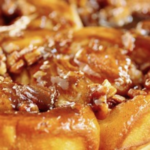It may be overcast here in New York, but we’re still feeling optimistic about those sure-to-come days of sunshine and warm weather. In honor of the season, we asked prolific gardener and accomplished cook Barbara Damrosch, author of The Garden Primer, to answer a few questions about how to reap the fruits (literally) of the spring harvest. Read on for her answers (they’re just below the photo of the charming New England kitchen where Barbara crafts meals that often start with her homegrown produce!).
Has spring sprung in Maine—or is your garden still under a blanket of snow?
Still a blanket, but there are some holes in it. Winter hangs on very late on the coast of Maine, because the ocean takes so long to warm up. Temperatures are still in the 30s, and it’s April! But some of my favorite signs of spring have appeared: the killdeer that build their perfect four-egg nests in our fields, the pussy willows, and, of course, mud. Living, breathing mud.
What fruits and vegetables are in season now? Which is your favorite?
Since we grow partly in greenhouses at Four Season Farm, there is quite a bit in season now. We’ve been harvesting spinach since fall in unheated greenhouses, joined in early March by baby leaf salad mix, head lettuce, arugula, radishes, tatsoi, Chinese broccoli, pac choi and scallions. My favorite is the pac choi, picked when the heads are only about 8 inches long. They’re deliciously mild and tender, the tops bright green and the white stems crisp and succulent.
How do you plan to prepare them?
I use them cooked in stir-fries and raw in salads, but my favorite thing is to slice them and serve them raw underneath fresh seafood. Tuesday night they were topped with lemony salmon. Tonight it’s going to be tiny Maine shrimp seared in garlic butter, and round red radishes sliced very thin.
What fruit or vegetable are you most looking forward to harvesting come summer?
I’d have to name three. Heirloom tomatoes such as Brandywine and Striped German. Charentais melons, perfumed and sweet. And raspberries, eaten by the handful right in the row. And a fourth: garden peas eaten the same way.
Any quick advice for gardeners looking to prep their tracts for the spring?
The most important thing is to keep from handling the soil until it has dried out. It should feel like a squeezed-out sponge, not a dripping one. Otherwise, you’ll do great damage to the soil’s structure. That’s why it’s best to dig or till in any soil amendments in fall. If you have done that, you could poke in early peas while it’s still a bit moist. Otherwise wait a while to dig in that all-important compost, even if it means missing out on some early crops. If it’s an unusually long, wet spring, use boards to walk on in the garden, and apply the compost on the soil surface, on each side of the row. It will work its way in later as you weed and cultivate.
Complete this sentence: When I’m not gardening or cooking, I can most often be found…
At the computer, writing books for Workman and my weekly column “A Cook’s Garden” in The Washington Post.






No Comments